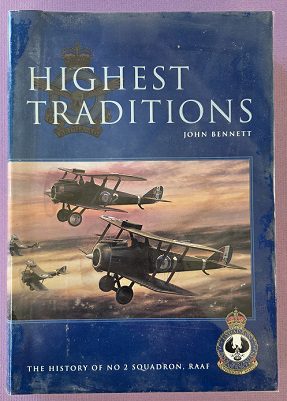Description
Title: Are you there Don R? No. 18 Squadron RAAF
Author: Wallace, Gordon
Condition: Very Good +
Edition: 1st Edition
Publication Date: 1983
ISBN: 095912540X
Cover: Hard Cover with Dust Jacket – 180 pages
Comments: The history of No 18 Squadron, RAAF.
Dutch airmen who escaped to Australia after the Japanese invasion of the Netherlands East Indies (NEI) were brought together to form Dutch squadrons under RAAF command. First among these special squadrons was 18 (NEI) Squadron, formed at Canberra on 4 April 1942. Although nominally made up of Dutch nationals, the RAAF supplied many co-pilots, air gunners, bombardiers, photographers, and ground staff. The US provided supplies and equipment.
Engagement with enemy forces came early for 18 Squadron when, on 5 June 1942, unit B-25s sunk a 300-ton Japanese submarine off Sydney. This success resulted in the supply of 18 B-25s between August and September. In December the unit moved to MacDonald airstrip in the Northern Territory and began transforming the undeveloped site into a workable airbase. From January the squadron commenced offensive operation missions over East Timor and the Tanimbar and Kai Islands.
During a raid on Dili on 18 February 1943 a Mitchell aircraft was forced down at sea. The crew, later rescued by HMAS Vendetta, explained that the pilot and bombardier had been killed in the attack. Moreover, while the survivors were in their lifeboat the co-pilot was attacked by a shark and a large sea bird had to be beaten back.
The squadron moved to Batchelor airfield in the Northern Territory between April and May 1943. It commenced reconnaissance over Somniloguy Island, Tanimbar Island, and Ambon, and offensive operations on Penfoei, Koepang Harbour, and Dili. Mast-height attack on Japanese shipping and faulty delay-action fuses inflicted substantial losses during the period.
Between November 1943 and March 1944 18 Squadron was ordered to prevent Japanese reinforcements reaching the north-east part of Papua and New Guinea. Operations focused on attacking positions and seaborne traffic around Timor, Ambon, and the Kai and Aroe Islands. The sinking of over 25,000 tones of Japanese ships earned the unit the nickname “the Dutch cleanser”.
On 10 March 1944 the unit was moved to an airbase on the Exmouth Gulf in Western Australia in anticipation of a Japanese attack on the Australian mainland. Two weeks later, when the threat proved empty, squadron aircraft returned to Batchelor and resumed operations over Dutch New Guinea. From mid-1944 the number of Japanese fighters decreased and 18 Squadron aircraft began searching for prisoner-of-war camps across Java and dropping leaflets. Anti-shipping patrols continued and on 6 April 1945, in combination with Liberator bombers from 21 Squadron, 11 B-25s from 18 Squadron bombed the Japanese light cruiser Isuzu, which was evacuating troops from Timor. The damaged cruiser was sunk the next day by Allied submarines. Shortly after this success the squadron moved to Balikapan to continue to drop leaflets, food, and medical supplies to prisoners held in Java, Borneo, and the Celebes.
On 25 November 1945 the RAAF component of the squadron was disbanded. Two months later the unit officially passed to Dutch control, flying against the Indonesian nationalists. Indonesian independence saw 18 Squadron handed over to the Indonesians and it was disbanded on 26 July 1950.
Signed by Author



